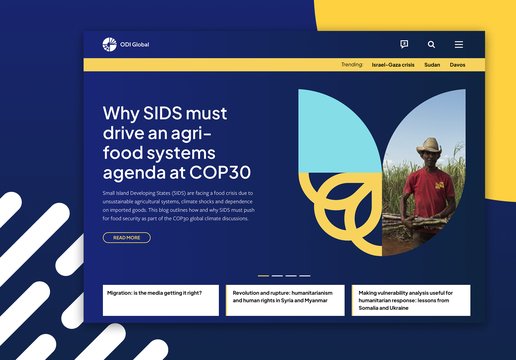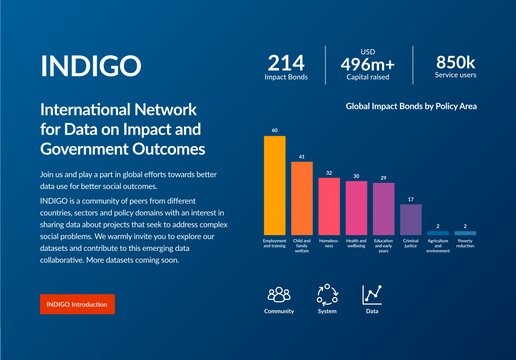If you’ve ever wrestled your CMS just to publish a blog post, you’ll get it. Your previews don’t show. The dashboard’s a cockpit. Someone sneezes near a plugin and four pages mysteriously die in solidarity.
Wagtail doesn’t do that.
To an editor, it feels like writing. To a developer, it feels like Django. To a comms team, it feels like finally having control. And to our clients – universities, charities, think tanks, cultural institutions – it feels like the first CMS built to match the pace, purpose, and pressure of their work.
Since 2017, we’ve helped mission-driven organisations take back control from unwieldy digital content management systems. Whether you’re starting fresh or already have a Wagtail website, we’re the expert partner to build, support, and grow your platform – with proactive, human-centred digital care that won’t leave you in the lurch after launch.
What is Wagtail CMS?
Wagtail is an open-source content management system built on Django – a robust, secure web framework written in Python. For developers, that means code-lite flexibility and high performance. For everyone else, it means publishing made painless.
It’s clean, fast, and delightfully editor-friendly. No plugin chaos, no confusing dashboards, and definitely no “hope this doesn’t break the homepage” headaches. Whether you’re juggling multiple content streams, updating donation flows, or publishing a research piece before the 10am briefing, Wagtail lets you get in, do your job, and move on with your day.

Why we chose Wagtail over every other digital publishing platform
Before specialising in Wagtail development, we tried them all. WordPress. Drupal. SilverStripe. You name it. For web teams that needed an easy way to publish content on the web, only one stood out: Wagtail. Built with intention and dependable tools, it started a quiet revolution in the Land of CMS: reshaping how researchers, charities, think tanks, and public bodies brought their work into the world.
But you won’t have seen Wagtail on billboards. It doesn’t have a mascot shaped like a cloud. And it’s not out there tootin’ its own flugelhorn. Yet, it has every right to: it’s running the websites of the NHS, NASA, Google Blogs, MIT, the Royal College of Art, and Carbon Brief.
Why? For starters – it’s simple, secure, scalable, open-source, feature-rich, SEO-friendly, and *takes sharp intake of breath* beautifully built on dev-fave, Django. Seriously, we wouldn’t spend every day making and caring for Wagtail websites and platforms if we didn’t love and trust it.
Wagtail website examples in the wild
What it feels like to use Wagtail as an editor:
Morning! Plonk down your brew and log in.
- Wagtail’s dash greets you: clean, dark-mode optional, and easily searchable. You can see your recent work, content awaiting approval, and anything in progress.
- You create a page and write a campaign update. You can see a live preview as you type, and the visual page builder (StreamField) lets you add and rearrange sections like text, CTAs, block quotes, and images (which all live in an organised, paginated library).
- You schedule it to go live during tomorrow’s launch window. No scribbling “publish at 10am!!!” on a sticky.
- You hand it off to a moderator in one click. They leave a comment. The system catches any missing accessibility info before it goes live.
- Your campaign is approved. The page looks smart. You look even smarter.
Nobody’s chasing you. Nothing’s broken. Your cause has progressed, and you have time for another cuppa.
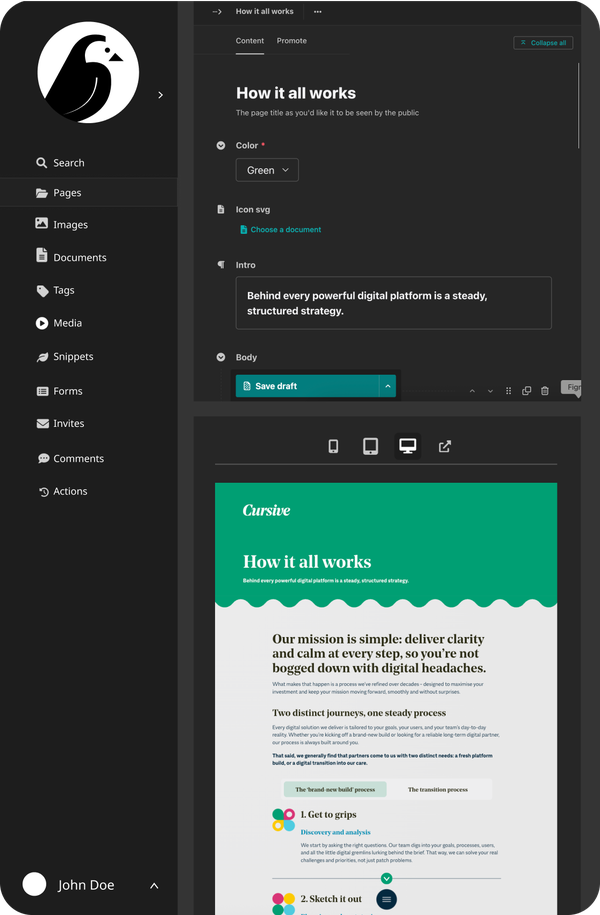
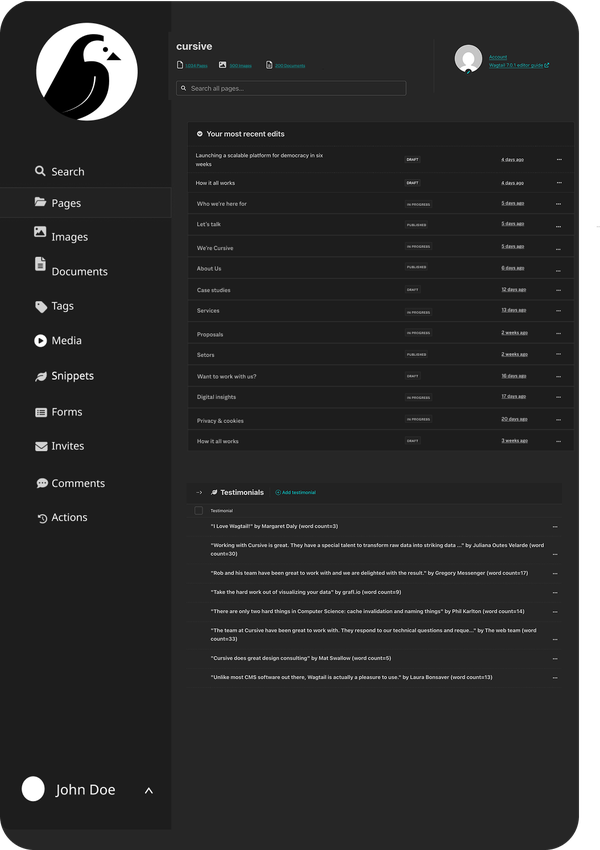
What it feels like to use Wagtail as a digital product owner:
It’s 9:17am. You log into Wagtail. It’s calm. It’s clean. There’s no backlog to tighten your chest.
- Your team’s already drafting content. The rich text is working, the buttons are buttoning, and the content is turning over like clockwork.
- You check in on that new page model. It’s live. Editors are using it. Granular permissions are in place, so no one can break anything. For the first time in a while, things are moving.
- Someone flags a glitch with a snippet. Pre-Cursive, this would’ve meant logging a ticket into the void and chasing it three days later with a sad emoji. But today, things are different. You flag the issue, send it to Cursive, and by 3pm it’s fixed. Same day. No drama.
- Leadership asks how it’s all going. You say, “Great.” And mean it.
Wagtail scales. It’s secure. It plays nicely with your digital ecosystem – your CRM, emails, booking engine, and the rest. This isn’t any old digital content delivery platform. It’s the one that doesn’t ruin your Tuesday.
Trusted by the people who built Wagtail
We have a great relationship with Torchbox – the very creators of Wagtail CMS.
The Wagtail team is continually improving software with new core features we can all benefit from. Plus, there’s a really active community of developers building features that help us solve even more niche problems. As a result, we’ve built Wagtail websites and platforms with complex workflows, enormous page-counts, multilingual (and multisite) structures, custom editorial tools, and accessibility baked in from day one.
If you already have a Wagtail website that’s grown arms and legs over years of iteration, bolt-ons, and multiple contributing developers, our experts can plug into your team and bring clarity to complexities. Not with a rebuild, but with hands-on consultancy that strengthens your investment, respects your internal devs, and works through your backlog together.
There’s literally never been a problem we haven’t found the solution for with Wagtail.

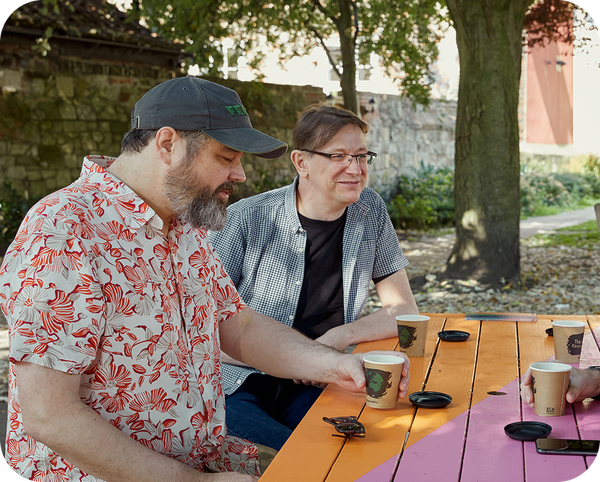
Why Wagtail CMS is built for orgs that publish at pace
For almost two decades, we’ve worked with mission-led teams to design, build, and look after digital content management platforms that help them meet urgent, ambitious goals – without buckling under the weight of daily content turnarounds. Under the hood, there are so many features our clients love:
Still wondering about Wagtail?
We totally get it – working with a brand new CMS or Wagtail developer is a big decision. If you’ve been left to install plugins alone or dealt with agencies that don’t prioritise aftercare in the past, you want to make sure you’re making the right choice. So here are a few things your stakeholders might want to know:
We can help. You may have already invested a significant amount of time and money in your website and be reluctant to start again from scratch. And the good news is, you may not need to. Whether you need fixes, improvements, or a backlog clearing out, we can jump into your current Wagtail setup and help you get more from it. We’ve transitioned several website projects into our care and been able to build on value already invested. Plus, we offer world-class hosting, support, maintenance, monitoring, upgrades, and can build new features that give users what they need to further your cause.
Absolutely. As creative Wagtail developers, we naturally love the opportunity to plan, design, and build web platforms from scratch – those projects are where we get to bring all our skills to bear. So if a brand new Wagtail website is what you need, we can work together to understand your objectives, leverage what’s working, change what isn’t, and give your organisation the website it deserves.
That’s our thing. Wagtail websites are just one part of how we help. We also do bespoke software development – applications, integrations with CRMs, research repositories, donation flows, dashboards – you name it. If it’s some kind of digital infrastructure for mission-led orgs, we’ve probably built it.
Yes. Wagtail is perfect for search engine optimisation (SEO), especially if your site is built with it in mind. The CMS doesn’t hold you back: it gives you clean, semantic HTML, fine-grained control over metadata, structured content models, and flexible routing. You can customise pretty much everything, which is ideal if your SEO strategy involves more than just adding keywords and hoping for the best.
And here’s the best part: Google uses Wagtail CMS for its blogs. So when it comes to crawlability, performance, and content clarity, it’s already passed the toughest reviewer in the game.
So good. In fact, it’s one of the reasons we use it. Wagtail makes it easier to build accessible websites that meet WCAG 2.1 AA and Section 508 standards from the ground up – without fighting against the CMS. We design and build WCAG-compliant websites that work for everyone, including people with visual or mobility impairments.
Not at all. Because Wagtail is built on Django, it’s a natural fit for existing Django sites. You can add Wagtail to an existing Django project, to introduce a powerful CMS without rewriting your whole stack. Where you might currently rely on Django admin or Django CMS to manage content, Wagtail gives your team a more intuitive, flexible editorial experience – with custom page types, reusable blocks, moderation workflows, and smart permissions baked in. And because it follows Django’s release cycle, updates are stable, well-documented, and predictable – no surprise breakages or headaches every six months.
If we’re building it, yes. We’ve passed every single one, with flying colours. We use secure-by-default frameworks (hello Django), write clean, reviewable code, and never roll our own crypto (because we like sleeping at night, too). If you’ve got compliance or IT teams to keep happy, we can work with them.
Not at all. Lots of teams come to us knowing something’s broken but have no idea what to fix first. We’ll help you untangle the mess, prioritise what matters, and avoid rebuilding things that already work. Discovery is all part of the process.
While we don’t have an exact number, we know Wagtail CMS is the quiet powerhouse behind thousands of websites globally, and a chunk of them are based right here in the UK. What matters more: Wagtail is the CMS of choice for a lot of smart, mission-led organisations here in the UK. Think the NHS, Office for National Statistics, the Royal College of Art, and loads of public bodies and nonprofits doing vital work. So, if you're trying to get approval for the switch internally: yes, Wagtail is proven, trusted, and very much in use across the UK.
Short version: because Wagtail doesn’t get in your way. We’ve built our fair share of websites on CMSs like WordPress, SilverStripe and Drupal and our clients have always been delighted with what we delivered. But whenever we had a seemingly simple request, it meant a lot of extra engineering work and a huge, complicated burden for future pages to carry. Those CMSs weren’t built to keep content editors happy. Wagtail CMS is. Developers love it. And your project lead trying to keep the whole thing together will really love it.
Many nonprofits, charities, and third-sector organisations use Wagtail because there’s no licence fee. And since it’s super secure, personal data from donors and supporters is stored safely. It’s brilliantly accessible and well built for SEO and sharing content across all social platforms. Not only that, but Wagtail’s page structure and editing tools make it ideal for websites with tens of thousands of pages and documents spread across lots of departments, managed by multiple teams and staff members. Just like this one we made for The University of Oxford.
Absolutely. We don’t do disappearing acts. We’ve supported clients for years, not weeks. And we’re not in this to burn through shiny projects – we’re here to build long-term platforms and partnerships that work. We stick around with real ongoing digital care, responsive support, and monthly check-ins – so you’re not left explaining why something still isn’t working to leadership.
Head and wings above the CMS alternatives
As a CMS, Wagtail gives content people a space that respects their time and craft. It gives developers control over their tools, without fighting the CMS. And it gives mission-led organisations the power to amplify causes on a global scale, with ongoing, proactive support from our friendly team of Wagtail developers.

